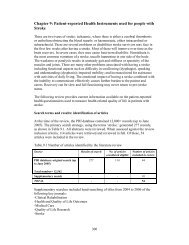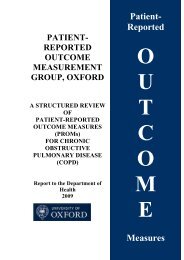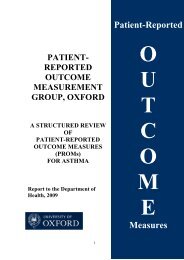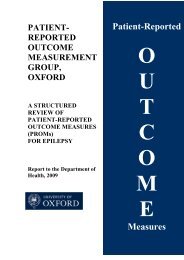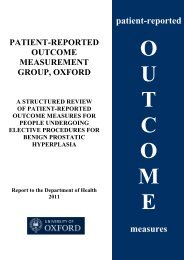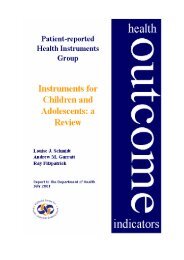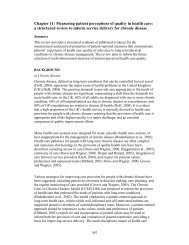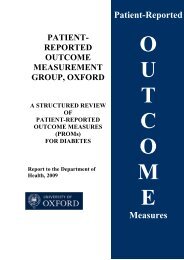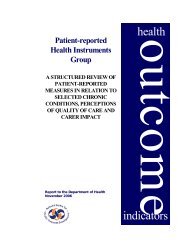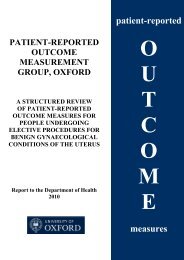2010 review - Patient-Reported Outcomes Measurement - University ...
2010 review - Patient-Reported Outcomes Measurement - University ...
2010 review - Patient-Reported Outcomes Measurement - University ...
You also want an ePaper? Increase the reach of your titles
YUMPU automatically turns print PDFs into web optimized ePapers that Google loves.
3. GENERIC PROMs<br />
Six generic measures were identified:<br />
a. Functional Status Questionnaire<br />
b. Nottingham Health Profile<br />
c. SF-36<br />
d. SF-20<br />
e. SF-12<br />
f. Sickness Impact Profile<br />
See Appendix B, Table iii for a summary of content and scoring of these instruments.<br />
a. Functional Status Questionnaire, FSQ (Jette et al., 1986)<br />
The US-developed FSQ was originally designed to assess physical, psychological, social, and<br />
role functioning in ambulatory patients. It has since been validated with hospital patients and<br />
in pharmaceutical trials. Questions were adapted from existing instruments, including the<br />
SIP. The measure comprises 34 items in four sections: physical function (Basic and<br />
Intermediate ADL scales), psychological function (MH); social/role function scales (Work<br />
Performance WP, Social Activity SA, Quality of Interaction QI), and six single items.<br />
Responses to subscale items are averaged and transformed into a 0-100 scale, where 100<br />
denotes maximum function. A computerised report can be generated, displaying scores in the<br />
form of VASs, with ‘warning zones’ to indicate important disability. The FSQ is selfadministered<br />
and takes approximately 15 minutes to complete.<br />
Three US studies were identified supporting the use of the FSQ with patients undergoing<br />
elective coronary procedures, the most recent being from 2004. Two of the studies examined<br />
outcomes of CABG; the third compared outcomes of CABG and PCI. Several additional<br />
studies were found which used only two or three FSQ subscales (fewer than 50% of FSQ<br />
items); these studies were excluded from the <strong>review</strong>.<br />
Internal consistency reliability of the FSQ was supported in a study comparing outcomes of<br />
patients undergoing either CABG or PTCA, with Cronbach’s alpha coefficients ranging 0.71<br />
to 0.99 (Allen et al., 1990). However, values greater than 0.95 suggest there may be some<br />
redundancy of items. Cronbach’s alpha ranged 0.69-0.87 for the CABG group in a study of<br />
patients undergoing one of four elective surgical procedures (Cleary et al., 1991; Six Hospital<br />
study).<br />
The IADL and SA subscales discriminated between treatment groups in the study by Allen et<br />
al. (1990), with PTCA patients having significantly better function in these domains at<br />
baseline and one month. By one year, however, IADL was similar in both groups, while<br />
CABG patients had significantly higher SA scores (Allen et al., 1990). MH and QI scores<br />
were not significantly different at baseline, but at six months, CABG patients had<br />
significantly higher scores in both domains; for MH, this difference was sustained at one year<br />
(Allen et al., 1990). These findings would appear to show that the FSQ reflected the different<br />
trajectories of recovery following the two procedures, with CABG patients having a longer<br />
post-operative recovery period and perhaps more realistic expectations with respect to the<br />
regaining of function (Allen et al., 1990).<br />
ADL, IADL, and SA subscales of the FSQ discriminated between older women and other<br />
demographic groups, and between patients who did and did not exercise, in a study of<br />
12



